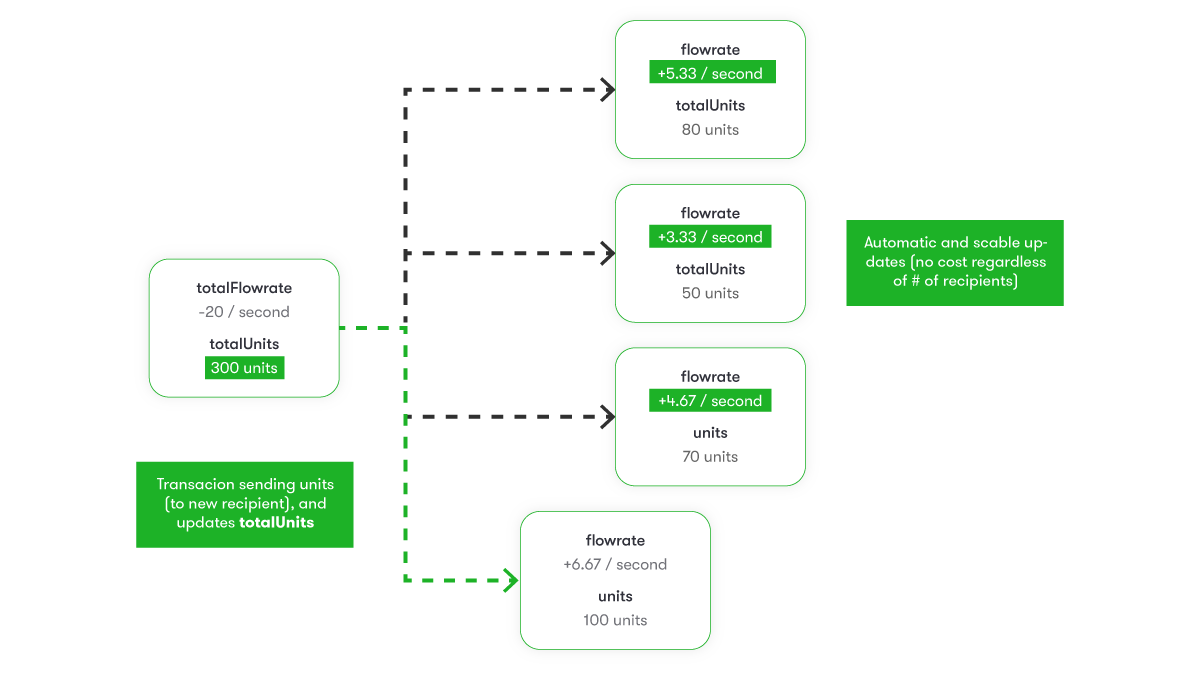Distributions
The introduction of Distributions marks a significant advancement in DeFi applications, offering a scalable method for one-to-many fund transfers. Distributions allow for the transfer of value to multiple recipients with minimal on-chain data modification, making them infinitely scalable, highly efficient and gas-friendly.
There are other on-chain solutions that may seem to solve this problem without using a new token implementation (e.g Disperse App). While these solutions can be great for a low amount of recipients, they are not infinitely scalable and can become very expensive as the number of recipients increases. Furthermore, they do not allow for distributing money streaming
Overview
Distributions function by allowing for the creation of pools with a designated pool admin who manages units for pool members. Members of these pools can receive funds either instantly or through continuous streaming, making this method highly efficient and scalable. There are two types of Distributions:
- Instant Distributions: They allow one transaction distribution to any number of receivers with a fixed gas cost.
- Streaming Distributions: They allow for continuous distribution of funds to receivers through Money Streaming to a Pool.
- Instant Distribution
- Streaming Distribution
Instant Distributions allow one transaction to distribute to any number of receivers with a fixed gas cost.
Click on the Blue Circle to initiate an Instant Distribution
By creating a Distribution Pool, you can distribute any token instantly
Instant Distributions allow for continuous distribution of funds to receivers through Money Streaming to a Pool.
Watch how the continuous stream gets distributed automatically through the pool
By creating a Distribution Pool, you can distribute any stream with no gas cost
Definitions
- Pool: A channel for proportional token distribution.
- Distribution: The action of allocating specified token amounts to receivers.
- Units: Represent the proportion of the distribution each subscriber receives.
- Pool Admin: The administrator of the distribution process.
- Subscribers/Pool Member: Receivers allocated units and eligible to receive tokens through the Index.
Key Features
- Pools as Contracts: Unlike previous approaches, pools in streaming distributions are contracts and can be ERC20 tokens. This allows pool members to transfer units among themselves, which wasn't possible earlier.
- Roles and Permissions: A pool admin can grant and revoke units, while any account can act as a distributor to execute fund distributions.
- Distribution Methods: There are two primary ways to distribute funds:
- Instant Distribution: Calculated as
distributionAmount * (poolMemberUnits / poolTotalUnits). - Streaming Distribution: Determined by
poolFlowRate * (poolMemberUnits / poolTotalUnits).
- Instant Distribution: Calculated as
- Gas Efficiency: The cost of executing distributions remains constant, regardless of the number of pool members.
High-Level Workflow
- Pool Creation: Any account can create a pool and appoint a pool admin. This pool acts as a channel for distributing funds.
- Unit Management: The pool admin assigns units to members, representing their share in future distributions.
- Member Connection: Pool members can connect to or disconnect from the pool, affecting how they access distributed funds.
- Distribution Execution: Distributors can initiate either instant or streaming distributions, which are then divided among pool members based on their unit share.
Distribution Examples
Streaming Distribution Illustration
This diagram shows a distributor streaming funds to various pool members, each holding different unit amounts. Note: A single transaction can cater to multiple members.

Adjusting Unit Counts
Here, a distributor modifies unit counts for members. This change instantly alters the distribution rate for all members in one transaction. Batch updates can be done using Superfluid's batch call.

Modifying the Flow Rate
This example demonstrates how a change in the distributor's streaming rate affects the total flow rate of the pool, thus instantly impacting each member's rate.

Advanced Pool Features
As pools are also ERC20 tokens, they enable:
- Transfer of Units: Pool members can freely transfer their units.
- Delegated Transfers: Using the
approveandtransferFromfunctions, units can be transferred on behalf of a member.
These features add composability and flexibility, expanding the potential use cases for pools in web3.